Press kit is an image booklet of your film, which contains detailed information about the project. It has an important role in the promotion, but ironically it is often overlooked by novice directors. We’ll name 7 hallmarks of an effective press kit.
The form and content of the press kit are similar to the presentation. Its main task is to draw attention to the film and to acquaint with the project as many professionals and viewers as possible. So it is primarily aimed at media representatives, festival selectors, and buyers.
How and where it is used
The press kit is sent to the organizing committee of the festival along with an application for participation or at the festival request when the film is already included in the competition program. As a rule, press kits are actively used by the PR departments of major festivals as advertising of the film and the film festival itself (in other cases, they serve as additional information material for selectors). Some festivals such as the Tribeca Film Festival publish press kits on their website, others place print versions at the information desks in the press rooms and distribute to the media before press shows. Often the press kit comes into the hands of journalists before the screening of the film, forming the first impression of the film and its author. Therefore it is necessary to work on it skillfully. The creation of a press kit is usually started when the film has received the first invitation to participate (in case of large and prestigious festivals) or if it is in the active period of the festival promotion.
1. Title page
The first page attracts attention and advertises your film. In a sense, it looks like a poster, which should include the following information:
-
film title;
-
contact information of the studio, producer company or director;
-
vivid quotes from media reviews on your film (briefly);
-
the names of the key members of the crew and the leading roles.
 It is also necessary to post information about previous participation in festivals and awards (laurel wreaths). You can generate these items at laurelleavesawardmaker.com.
It is also necessary to post information about previous participation in festivals and awards (laurel wreaths). You can generate these items at laurelleavesawardmaker.com.
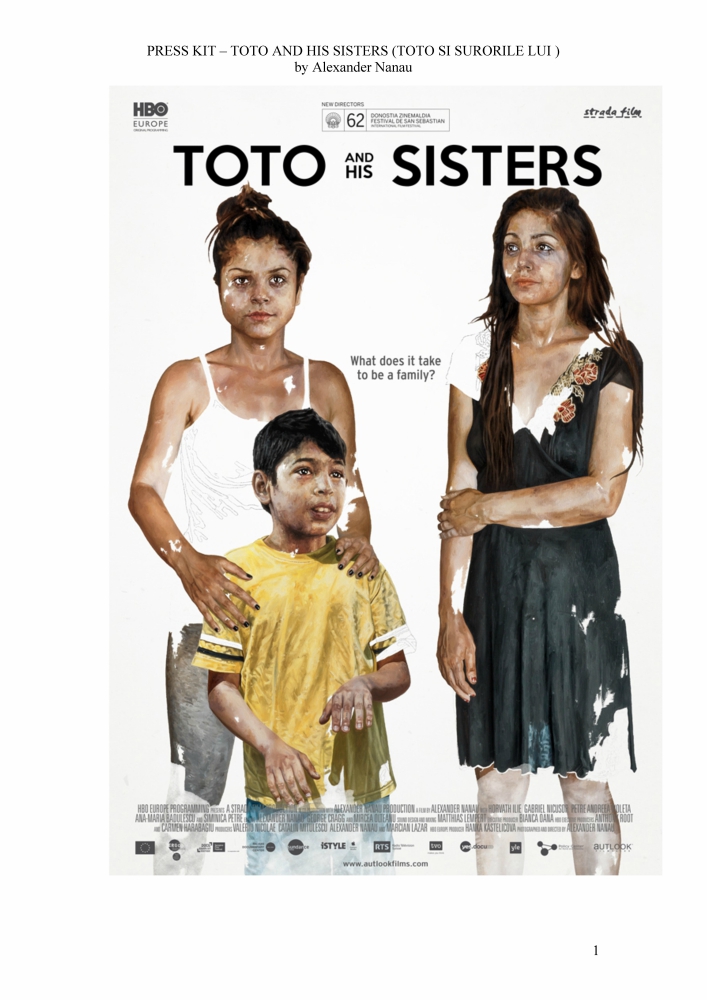


Complete Guide «How to make poster for a film»
2. Synopsis
Surely you already have a synopsis, since it is often written long before the film is made. If not, it must be urgently corrected. The synopsis is a brief and fascinating presentation of the film’s history that will intrigue the viewer from the first words. In no case should it look like a dry retelling of a plot or a monotonous listing of unfolding actions. It is better for the synopsis to have a mystery and understatement in it.
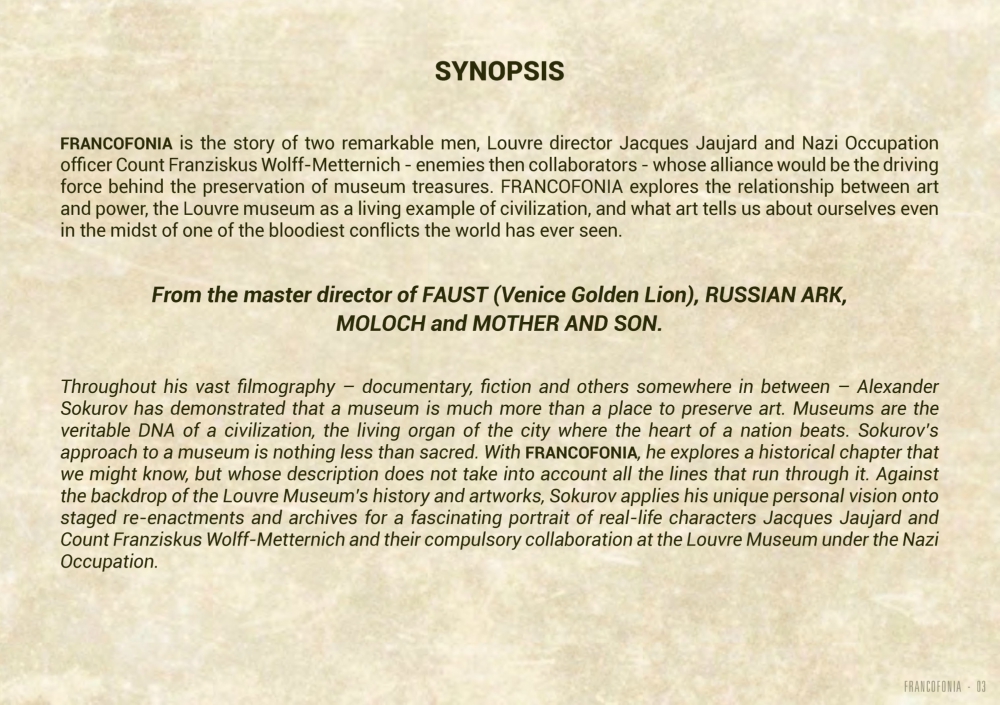
An example from the press kit of the film “Francofonia”, dir. Alexander Sokurov, France, Germany, the Netherlands, 2015, 88 min.
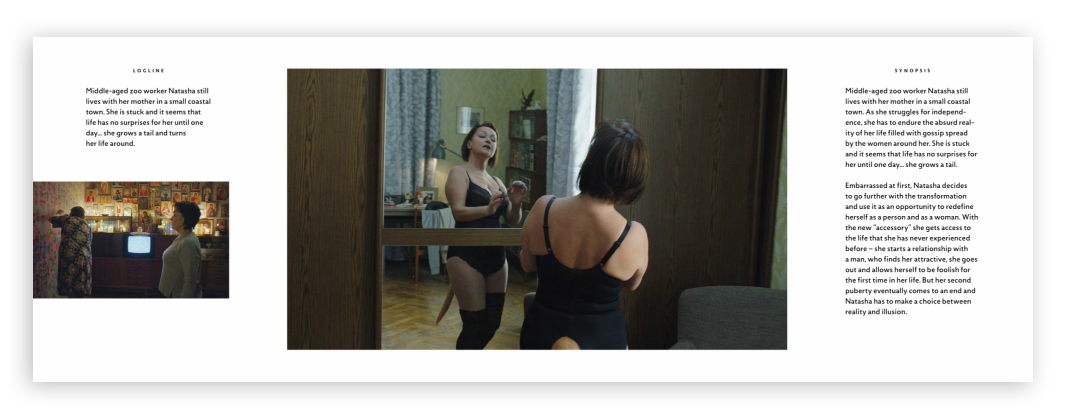
An example from the press kit of the film “Zoology”, dir. Ivan I. Tverdovsky, Russia, Germany, France, 2016, 91 min. Natasha works at the Zoo, she is over 30, and she still lives with her mother in a small seaside town. Struggling for her independence she must overcome the whole absurdity of this life, filled with rumors that are spreading around. She was given such a life in which nothing happens, until one day... her tail grows. Firstly confused Natasha then decides to go through her transformation to the end and use this opportunity for her inner rebirth as a man and as a woman. With this new accessory, she gets access to the life she previously could only dream of. She meets a man who considers her attractive. For the first time in her life, she allows herself to do stupid things. But this comes to an end, and Natasha must make a choice between the world of illusions and reality.
 On the same page, you can place frames from your film. It is important for them to be of good quality and reflect the aesthetics of your film work.
On the same page, you can place frames from your film. It is important for them to be of good quality and reflect the aesthetics of your film work.
Статья «Логлайн и синопсис: характеристики, особенности, требования»
3. Film crew
Special attention in the press kit is given to biographies of key members of the crew and the cast. Do not write about them all. Choose 3 or 5 leading members of the film crew, whose biographies will be listed in the press kit.
Whom to tell about
As a rule, you should mention the following people:
-
director,
-
scriptwriter,
-
producer,
-
leading cast.
A complete list of the crew can be placed on a separate page of the document.
What to say about
In biographies, you must write:
-
About experience in previous projects. For example: “The operator before the shooting of our film worked as an assistant for Alisher Hamidhojaev” or “The editing director collaborated with Linda on the video clip “Hang Me Up”.
-
About rewards that may have already been won at festivals.
-
About educational institutions. If you are a first-time filmmaker and you absolutely do not know what to write in the resume. Do not forget to specify the names of the masters of the course, if we are talking about cinema. Briefly tell about what you did before you decided to become a director.
If you have absolutely nothing to tell about yourself (or you just want to blow smoke in the eyes of journalists), you can write a biography as Colin McKenzie — a fictional New Zealand director who allegedly invented the movie, and Peter Jackson's “Forgotten silver” character.
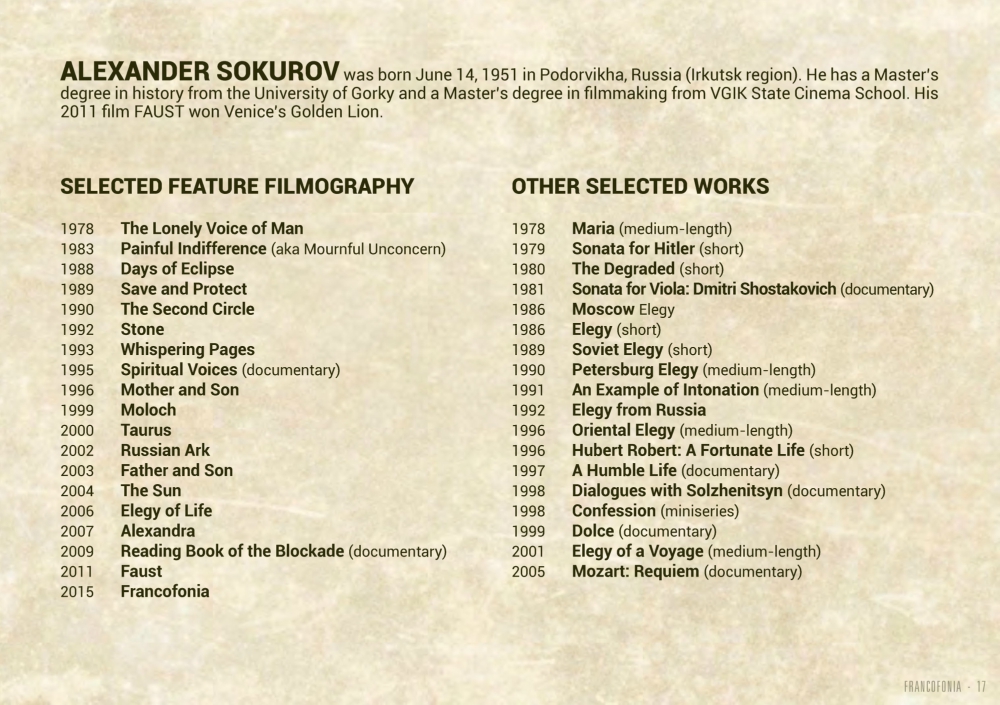
Regalia of Alexander Sokurov. An example from the press kit of the film "Francofonia".

Ivan I. Tverdvosky and the team. An example from the press kit of the film "Zoology".
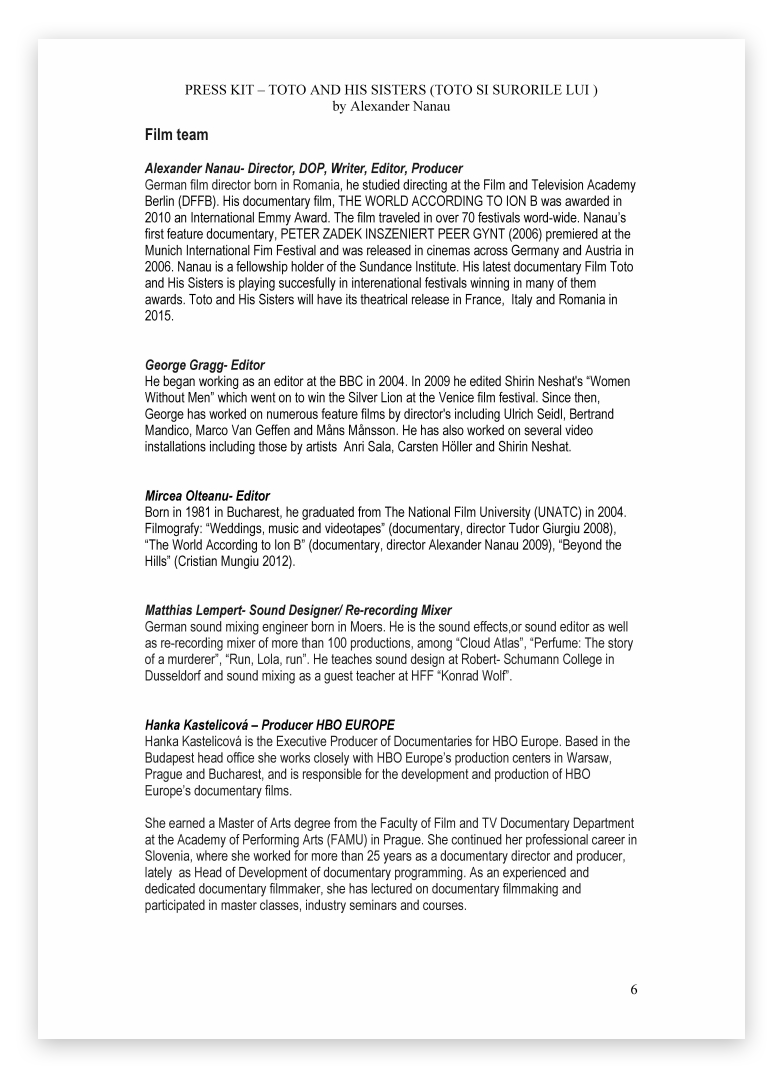
An example from the press kit of the documentary film "Toto and his sisters."

If a press kit is created for a full-length film, then the section with biographies should not take more than 3–4 pages, preferably with photos of the crew members. If we are talking about short film, it is better to fit in one, maximum two pages.
4. 10 Frequently Asked Questions
This is one of the most useful sections of the press kit, which many people forget. Here you can try to predict questions that most likely the viewers will have after watching your film and answer them yourself. “10 questions” is a great way to tell what seems important to you in a film and in working on it.
The section allows you to:
-
accurately convey the director's intention,
-
pay attention to important details,
-
put the right accents,
-
designate the context in which the film was created and exists.
As a rule, these are questions that you ask in the process of work or hear them from the participants of the focus group. For example, how the idea of the film came up to you, where the title came from, how you managed to persuade Fyodor Bondarchuk to play in a movie. It may also be issues related to the plot of the film, which say for themselves.
 By the way, you can arrange the section in the format of an interview with the director.
By the way, you can arrange the section in the format of an interview with the director.
5. Photos
Choose the most intense day of shooting and invite a photographer to the set who will make expressive promotional photos of your film. The photographer will need 4 types of pictures:
- Shots of the key film scenes. Remember that the photographer can not take pictures directly during the shooting of the picture, otherwise, the microphones will record shutter clicks. After a suitable take, ask the actors to stay in place and repeat the scene for the photographer.
- Images from the shooting set: actors, crew, entourage. Show as much cinema equipment as possible or fragments of built scenery, as well as members of the film crew inside the process. Make sure that these photos carry a meaningful and conceptual load because one picture can stand for a thousand words.
- Director’s photo. It is better if this photo is taken at work on the set. Well, if the director is depicted in the process of hectic activity and among the actors.
- Photos with celebrities. Even if celebrities do not take part in your film, try to invite someone from the media and people respected in the film industry to your film set. Ask the photographer to be ready and take a few reportage shots; at least, you can politely ask the guest to share a photo with you. Shots demonstrating the involvement of famous people can become both a magnet and a conductor.
 Make sure that on the finished picture you will be the first on the left: this ensures that in the caption to the photo your name will stand in front of the others.
Make sure that on the finished picture you will be the first on the left: this ensures that in the caption to the photo your name will stand in front of the others.
6. Reviews on your movie
Ask familiar journalists, film experts and representatives of the local film industry to watch your film and write a short comment. Even if someone doesn’t like the picture, you will surely find one or two bright phrases in the review that will be useful for a press kit. Feel free to collect opinions on the film. This is mutually beneficial cooperation: you have a review, and the name of the reviewer is printed in the press kit. In the event of successful festival history, both will be mentioned. In addition, many Russian film critics work as selectors at festivals, arouse their professional interest in you and your work.
 In the same section, you can give links to already existing materials in your film.
In the same section, you can give links to already existing materials in your film.
7. Technical information
This is a technical description of your movie, which should include the following characteristics:
- shooting format (35 mm, 16 mm, digital),
- aspect ratio (16x9, 4x3),
- audio format (5.1, stereo),
- length,
- the original language of the film.

In the press kit, you must specify the age limit.
Create a press kit
Instruments. You can create a press kit in well-known graphic editors:
- Adobe Illustrator is a vector graphics editor developed and distributed by Adobe Systems.
- Adobe Indesign is a computer layout program developed by Adobe Systems. InDesign is the next advanced layout program after PageMaker.
- CorelDRAW is a graphics editor developed by the Canadian corporation Corel. The current version of CorelDRAW Graphics Suite X8 is available only for Microsoft Windows. Earlier versions were also available for Macintosh and Linux.
Or, if you do not have the time and desire to study these programs in graphic design, you can use an accessible online editor:
Format. The standard for the press kit is a file in pdf format. This is the most universal option that will be accepted at the festival of any country unless other conditions are provided. We recommend requesting technical requirements in advance.
Size and orientation. Of course, you can experiment — A5, 4:3, 20x20. But here you should also remember the realities: most of the monitors existing in our time are horizontal in orientation, and in 9 cases out of 10, your file will be printed on standard A4 sheets. Keep this in mind when you typeset a press kit only for selectors (electronic version) or for journalists (printed version). In addition, A4 can be easily printed in any printing house, therefore, the cost of printing will be lower than for other formats.
The seal. The harsh truth of life is this: in order to distribute a press kit before a press show, one often uses a black and white version without pictures and frames from films. However, this does not mean that the selection of materials can be treated casually - illustrations should still be of high quality and in the right places.
During press kit layout, keep in mind that most printers are set to save technological fields (a white frame around the perimeter of the sheet). Therefore, do not distribute the file "to the edge".
And the three cherished NOT for a press kit, intended for printing:
-
Do not make a fine print.
-
Do not make a gray background.
-
Do not make color edit. Only image and text.
This will improve the visual "readability" of materials and reduce paint consumption.
 In the output, be sure to include links to HiRes — large images. You can store them on the cloud service.
In the output, be sure to include links to HiRes — large images. You can store them on the cloud service.
Text: Ekaterina Rusakovich
See also: